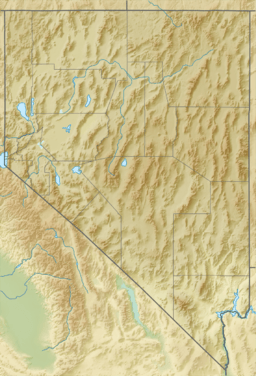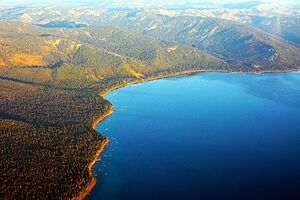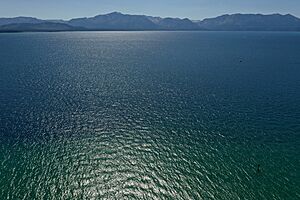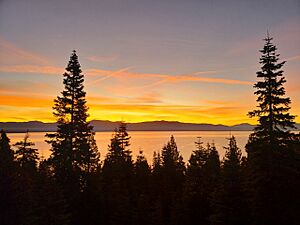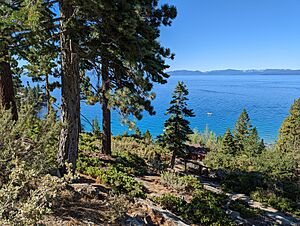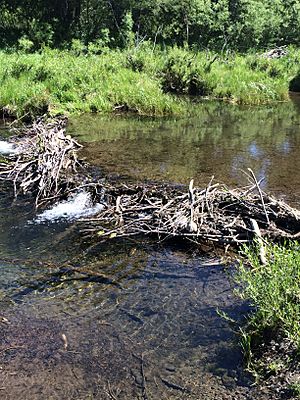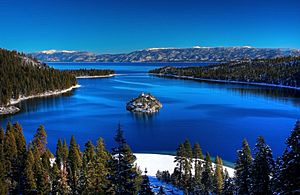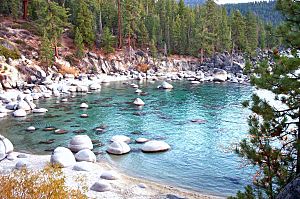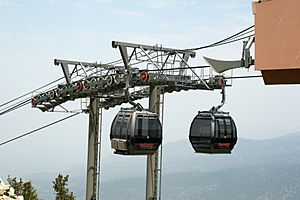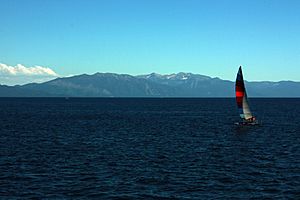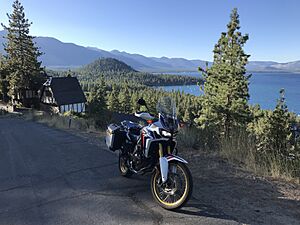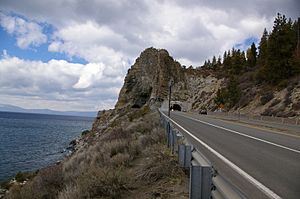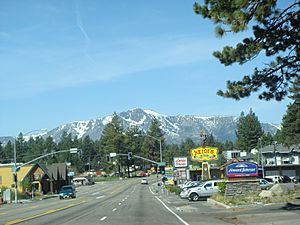Lake Tahoe facts for kids
Quick facts for kids Lake Tahoe |
|
|---|---|
| Dáʔaw (Washo) | |
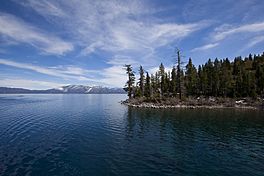
The south shore of Lake Tahoe in California, as seen from the west shore
|
|
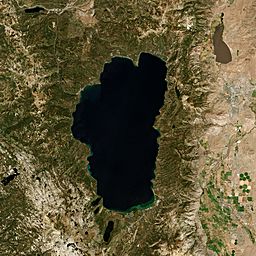
Lake Tahoe from space
|
|
| Location | The Sierra Nevada of the U.S., along the state line of California and Nevada |
| Coordinates | 39°N 120°W / 39°N 120°W |
| Lake type | Ancient lake, Geologic block faulting |
| Primary outflows | Truckee River |
| Basin countries | United States |
| Max. length | 22 mi (35 km) |
| Max. width | 12 mi (19 km) |
| Surface area | 191 sq mi (490 km2): Placer County (41%) El Dorado County (29%) Douglas County (13%) Washoe County (11%) Carson City (6%) |
| Average depth | 1,000 ft (300 m) |
| Max. depth | 1,645 ft (501 m) |
| Water volume | 36 cu mi (150 km3; 120,000,000 acre⋅ft) |
| Residence time | 650 years |
| Shore length1 | 71 mi (114 km) |
| Surface elevation | 6,225 ft (1,897 m) |
| Frozen | Rarely, in Emerald Bay |
| Islands | Fannette Island |
| Settlements | Incline Village, NV South Lake Tahoe, CA Stateline, NV Tahoe City, CA Kings Beach, CA |
| 1 Shore length is not a well-defined measure. | |
Lake Tahoe (pronounced TAH-ho) is a large, beautiful freshwater lake. It sits high up in the Sierra Nevada mountains, right on the border between California and Nevada. The lake is about 6,225 ft (1,897 m) above sea level.
Lake Tahoe is the biggest alpine lake in North America. It's also one of the largest lakes in the United States by volume, only smaller than the five Great Lakes. At 1,645 ft (501 m) deep, it's the second deepest lake in the U.S., after Crater Lake in Oregon.
The lake was formed around two million years ago. Its clear water and the amazing mountains around it make it very famous. People often call the whole area "Lake Tahoe" or just "Tahoe." Its name comes from the Washo word Dáʔaw, which means 'the lake'. Most of the land around the lake is protected national forest land.
Lake Tahoe is a popular place for tourists in both Nevada and California. People enjoy winter sports like skiing, and summer activities like swimming and boating. The area is known for its ski resorts. On the Nevada side, there are also casinos. Highways make it easy to visit the lake all year round.
Contents
What's in a Name?
The name Lake Tahoe comes from the Washo word Dáʔaw. This word simply means 'the lake'. The Washo people used this name for Lake Tahoe because it was very important to their culture.
Lake Tahoe's Geography
Lake Tahoe is the second deepest lake in the U.S. Its deepest point is 1,645 feet (501 m). It is about 22 mi (35 km) long and 12 mi (19 km) wide. The shoreline stretches for 72 mi (116 km). The lake's surface is so big that you can actually see the curve of the Earth on it!
About two-thirds of the lake's shoreline is in California. The biggest city on the lake is South Lake Tahoe, California. It's next to Stateline, Nevada. Other towns include Tahoe City, California on the northwest side, and Kings Beach, California and Incline Village, Nevada on the north side. Many parts of the shoreline are protected state parks or national forest land.
Lake Tahoe gets its water from 63 smaller streams. These streams drain an area about the same size as the lake itself. They provide half of the lake's water, with the other half coming from rain and snow falling directly on the lake.
The Truckee River is the only river that flows out of Lake Tahoe. It flows northeast through Reno, Nevada, and ends in Pyramid Lake. About one-third of the water leaves through the Truckee River. The rest evaporates from the lake's surface. The flow of the Truckee River and the lake's height are controlled by the Lake Tahoe Dam.
Natural History of Lake Tahoe
How Lake Tahoe Was Formed
The Lake Tahoe Basin was created by huge movements in the Earth's crust. Blocks of land were pushed up to form the Carson Range to the east and the Sierra Nevada mountains to the west. The land in between dropped down, forming the basin where Lake Tahoe now sits. This is similar to how other areas in the nearby Great Basin were formed.
There are three main faults (cracks in the Earth's crust) that shaped the Lake Tahoe basin. The West Tahoe Fault is the most active and could cause earthquakes. Studies show that the last big earthquake on this fault happened about 4,100 to 4,500 years ago. These earthquakes can cause huge waves, called tsunamis, in the lake. Some past tsunamis might have been as tall as 330 ft (100 m)!
Some of the tallest mountains around Lake Tahoe were formed during this process. These include Freel Peak (10,891 feet (3,320 m)), Monument Peak (10,067 feet (3,068 m)), and Mount Tallac (9,735 feet (2,967 m)).
An ancient volcano called Mount Pluto erupted and created a natural dam on the north side of the basin. Melting snow then filled the lowest part of the basin, forming the first Lake Tahoe. Rain and runoff added more water over time.
During the Ice Ages, huge glaciers carved out the canyons around Lake Tahoe. These glaciers created famous places like Emerald Bay and Fallen Leaf Lake. Lake Tahoe itself was never covered by glaciers.
Lake Tahoe's Climate
Lake Tahoe has a climate with warm, dry summers and cold, snowy winters. Most of the rain and snow falls between November and April. Heavy snowmelt in late spring and early summer can cause floods.
August is usually the warmest month, with average high temperatures around 78.7 °F (25.9 °C). January is the coldest, with average low temperatures around 15.1 °F (−9.4 °C). It can get very cold, with temperatures sometimes dropping below 0 °F (−18 °C). Freezing temperatures can happen in any month of the year.
Lake Tahoe never completely freezes over because it is so deep. The lake's temperature has been slowly warming over the years. This warming might affect how clear the water is and how nutrients move around in the lake.
Plants and Animals
The forests around Lake Tahoe are mostly made up of different types of pine and fir trees. You can also find wet and dry meadows, brushy areas, and rocky spots. The rare Lake Tahoe yellowcress plant grows only on the lake's wet sandy beaches.
The lake used to have native algae and plants like Chara and coontail. But new plants like curlyleaf pondweed and Eurasian watermilfoil have been introduced. These new plants have changed the environment near the shore.
Native fish in the lake include the Lahontan cutthroat trout. However, many of these native fish have been greatly reduced because of fish and other creatures introduced from other places. For example, the cutthroat trout disappeared from the lake in the early 1900s but efforts to bring them back started in 2019.
Some fish that have been introduced to the lake are lake trout, rainbow trout, and sockeye salmon. Each autumn, sockeye salmon turn bright red and swim up Taylor Creek to lay their eggs. After laying eggs, they die, and their bodies become food for animals like mink, bears, and bald eagles.
North American beavers were brought back to the Tahoe Basin between 1934 and 1949. Beavers have been seen in many parts of Lake Tahoe. Studies show that beaver dams can help keep the lake's water clear by trapping nutrients and sediments.
The lake's cold temperatures and extreme depth can slow down how fast things break down. For example, a diver's body was found almost perfectly preserved 300 feet (90 m) deep, 17 years after he went missing.
Human History of Lake Tahoe
Native Peoples
The area around Lake Tahoe was originally home to the Washoe Native Americans. Lake Tahoe was the most important place in their territory.
Cave Rock on the southeastern shore is a sacred site for the Washoe. They called it deʔek wadapush, meaning 'Standing Gray Rock'. The Washoe performed religious ceremonies inside the cave.
How Lake Tahoe Got Its Name
Lt. John C. Frémont was the first European-American to see Lake Tahoe in 1844. He named it "Lake Bonpland." This name didn't stick. Later, it was called "Lake Bigler" after California's governor, John Bigler.
However, during the American Civil War, Governor Bigler supported the Southern states. People who supported the Union didn't like the name "Lake Bigler." In 1862, a mapmaker named William Henry Knight and a colleague suggested the name "Tahoe." They believed it meant "water in a high place" in the local tribal language.
The name "Lake Tahoe" became more popular over time. Even though some people, like writer Mark Twain, didn't like the new name, it eventually won out. In 1945, the California State Legislature officially changed the name to Lake Tahoe.
Mining and Early Transportation
When gold was discovered in California in 1848, many gold seekers passed near Lake Tahoe. Later, silver was found nearby in Nevada in 1858. From 1858 to about 1890, trees from the Lake Tahoe basin were cut down to support the silver mines. This logging was so widespread that almost all the native forest was cut.
Lake Tahoe became a busy place for transportation. Steamboats carried mail and logs across the lake. The first steamboat was the Governor Blasdel in 1863. Later, faster steamboats like the Governor Stanford and the Tahoe carried passengers and mail. As cars became more common, the steamboats were used less.
Modern Development
Even during the mining times, people saw that Lake Tahoe could be a great place for tourists. Tahoe City was started in 1864 as a resort town.
After World War II, more people moved to the area. Gambling casinos were built on the Nevada side in the 1950s. The 1960 Winter Olympics were held nearby, which also brought more development. The number of people living there permanently grew a lot between 1960 and 1980. Since the 1980s, new rules have slowed down building to protect the lake.
While Lake Tahoe is a natural lake, its water level is controlled by the Lake Tahoe Dam. This dam was built in 1913 at the start of the Truckee River.
Historic Places to See
Lake Tahoe is home to several historic, grand homes. The Thunderbird Lodge once owned by George Whittel Jr. covered almost 27 miles (43 km) of the Nevada shoreline. Vikingsholm is a beautiful old home on Emerald Bay. The Ehrman Mansion is another historic summer home that is now a state park.
Protecting Lake Tahoe
Water Quality Concerns
Building around the lake has caused its clear blue water to become cloudier. This is because fine dirt and tiny particles from roads and construction wash into the lake. This is called "urban stormwater runoff."
Scientists measure the lake's clarity using a Secchi disk. The clarity has been decreasing over many years. However, from 2011 to 2014, the lake's clarity actually improved by almost 20 percent.
Changes in the Ecosystem
Since the 1960s, the plants and animals in Lake Tahoe have changed a lot. In the 1960s, tiny opossum shrimp were introduced to feed the Kokanee salmon. But these shrimp ate the lake's native tiny creatures, called cladocerans, which almost disappeared.
Recently, large goldfish have been seen in the lake. These are an invasive species, likely from pets that were released. They can harm the lake's ecosystem.
In 2007, the Angora Fire burned a large area near South Lake Tahoe. The ash from the fire had little effect on the lake. But future erosion from the burned land could still impact the water.
Protecting the Lake
Rules are in place to control building near the shoreline to protect the lake's water. The League to Save Lake Tahoe, also known as "Keep Tahoe Blue," has worked for over 50 years to protect the lake. They fight against development that could harm the environment.
Scientists also monitor the lake's water quality. They measure nutrients and sediment in the streams that flow into the lake. This information helps them plan how to keep the lake healthy.
In 2019, tiny pieces of plastic, called Microplastics, were found in Lake Tahoe. These can come from local pollution or be carried by wind and rain from far away. In 2023, studies showed Lake Tahoe has some of the highest microplastic pollution among many lakes. Groups are working to remove these plastics and trash from the lake bottom.
The UC Davis Tahoe Environmental Research Center studies the lake and shares information. Each year, they publish a "State of the Lake" report. This report tells us about changes in water clarity, nutrients, and weather around the lake.
Things to Do at Lake Tahoe
Much of the area around Lake Tahoe is focused on tourism. There are many restaurants, ski slopes, golf courses, and casinos for visitors. The Nevada side has more tourist attractions because gambling is legal there.
Winter Sports
In winter, thousands of people come to Lake Tahoe for downhill skiing. The area is known for its heavy snowfalls.
Some of the main ski areas are:
- Heavenly Mountain Resort: The biggest ski area in California and Nevada.
- Palisades Tahoe: The second largest ski area, famous for hosting the 1960 Winter Olympics.
- Northstar California: A popular ski area known for its terrain park.
- Kirkwood Mountain Resort: Gets more snow than other ski areas in the region.
- Sierra-at-Tahoe: A medium-sized ski area on the south shore.
- Mount Rose Ski Resort: A ski area northeast of the lake.
Many ski resorts also offer snow tubing. You can also enjoy cross-country skiing, snowmobile riding, and snowshoeing around Tahoe.
Water Sports
From late spring to early fall, the lake is popular for water sports and beach activities. You can go parasailing, rent jet skis, or try eco-friendly paddle sports like kayaking and stand-up paddleboarding. Fishing is also popular.
Boating is a major summer activity. Lake Tahoe hosts a famous wooden boat show every August. There are many lakeside restaurants with docks for boats. You can also enjoy sailboat races and guided cruises. The United States Coast Guard has a station on Lake Tahoe.
SCUBA diving is also popular. Divers can explore dramatic drop-offs. Diving at Lake Tahoe is considered advanced because of the high altitude, which means divers need to be careful about decompression sickness.
Fred Rogers was the first person to swim the entire length of Lake Tahoe in 1955. Erline Christopherson was the first woman to do so in 1962.
Motorcycling
The roads around Lake Tahoe are great for motorcyclists. A popular route goes clockwise around the lake. It starts in South Lake Tahoe, California, and follows Highway 89, then Highway 28, and finally US-50. This ride offers amazing views.
Some scenic stops for motorcyclists include:
- Emerald Bay
- Fallen Leaf Lake
- Zephyr Cove
- Cave Rock
- Sand Harbor
- Kings Beach
- Donner Lake
Hiking and Bicycling
There are many trails for hiking and mountain biking around the lake. They vary in length and difficulty. The Tahoe Rim Trail is a famous 165-mile (270-km) trail that goes all the way around the lake.
To the west of the lake is the Granite Chief Wilderness. To the southwest is the popular Desolation Wilderness. Both offer great hiking and camping. The Flume Trail on the east shore is known as one of the top mountain biking trails in the U.S. There are also many paved bike paths.
Gambling
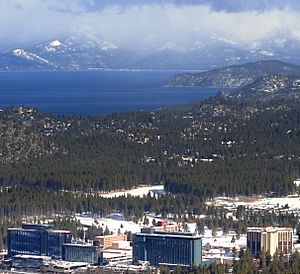
Gambling is allowed on the Nevada side of Lake Tahoe. There are casinos with slot machines and table games. Four casinos are in Stateline, Nevada on the South Shore. Four more are on the North Shore, in Crystal Bay, Nevada and Incline Village, Nevada.
The first casino at the lake, the Cal-Neva Lodge, opened in 1926. Famous singer Frank Sinatra even owned it in the early 1960s. Other casinos include Harrah's Tahoe, Hard Rock Hotel and Casino Lake Tahoe, and Harveys Lake Tahoe.
Getting to Lake Tahoe
You can reach Lake Tahoe by car and bus. The closest train station is in Truckee, served by Amtrak's California Zephyr train. An Amtrak bus also connects South Lake Tahoe to Sacramento. The nearest airports with scheduled flights are Reno-Tahoe International Airport (RNO) and Sacramento International Airport (SMF).
Local buses provide transportation around South Lake Tahoe and the north and northwest shores.
Highways Around Lake Tahoe
It takes about two hours to drive to Lake Tahoe from Sacramento, one hour from Reno, or thirty minutes from Carson City. In winter, you often need snow chains or special tires. Traffic can be heavy on weekends, especially with tourists or bad weather.
The main roads to Lake Tahoe are Interstate 80 (via Truckee), U.S. Route 50, and Nevada State Route 431 (via Reno). Most roads around the lake are two-lane mountain roads. US 50 passes south of the lake and along part of the eastern shore.
California State Route 89 follows the western shore, connecting parks and hiking spots like Emerald Bay State Park and DL Bliss State Park. California State Route 28 goes around the northern shore, through towns like Kings Beach and Crystal Bay, and into Nevada.
Major Airports Nearby
- Reno-Tahoe International Airport (RNO) in Reno, Nevada
- Sacramento International Airport (SMF) in Sacramento, California
- Lake Tahoe Airport (KTVL) in South Lake Tahoe, California
- Truckee-Tahoe Airport (KTRK) in Truckee, California
- Minden–Tahoe Airport (KMEV) in Minden, Nevada
Communities Around Lake Tahoe
California Communities
- Carnelian Bay #3
- Dollar Point #4
- Kings Beach #1
- Sunnyside-Tahoe City #5
- Tahoe Vista #2
- Tahoma (partially in El Dorado County) #6
- South Lake Tahoe #7
- Fallen Leaf Lake
- Tahoma (partially in Placer County) #6
- Tahoe Keys
Nevada Communities
- Carson City #14
- Glenbrook #13
- Lakeridge #11
- Logan Creek #12
- Round Hill Village #8
- Skyland #10
- Stateline #17
- Zephyr Cove #9
- Crystal Bay #16
- Incline Village #15
Lake Tahoe in Movies and Music
The old Ponderosa Ranch from the TV show Bonanza used to be on the Nevada side of Lake Tahoe. The opening scenes of the show were filmed there.
The 1974 movie The Godfather Part II used the beautiful Fleur de Lac estate on the lake for many scenes. This estate was once owned by Henry Kaiser. Some of the original buildings from the "Corleone compound" still exist today.
The 2014 film Last Weekend was filmed at a lakefront home on the west shore. This house was also used for outdoor scenes in the 1951 movie A Place in the Sun, starring Elizabeth Taylor.
The British rock band A has a song called "Here We Go Again (I Love Lake Tahoe)." The song and its music video are all about the band's love for the lake.
The lake is also mentioned in the song "Unfair" by the indie rock band Pavement.
Singer Kate Bush has a song called "Lake Tahoe" on her album 50 Words for Snow. In the song, a woman who drowned in the lake is reunited with her dog.
See also
 In Spanish: Lago Tahoe para niños
In Spanish: Lago Tahoe para niños



